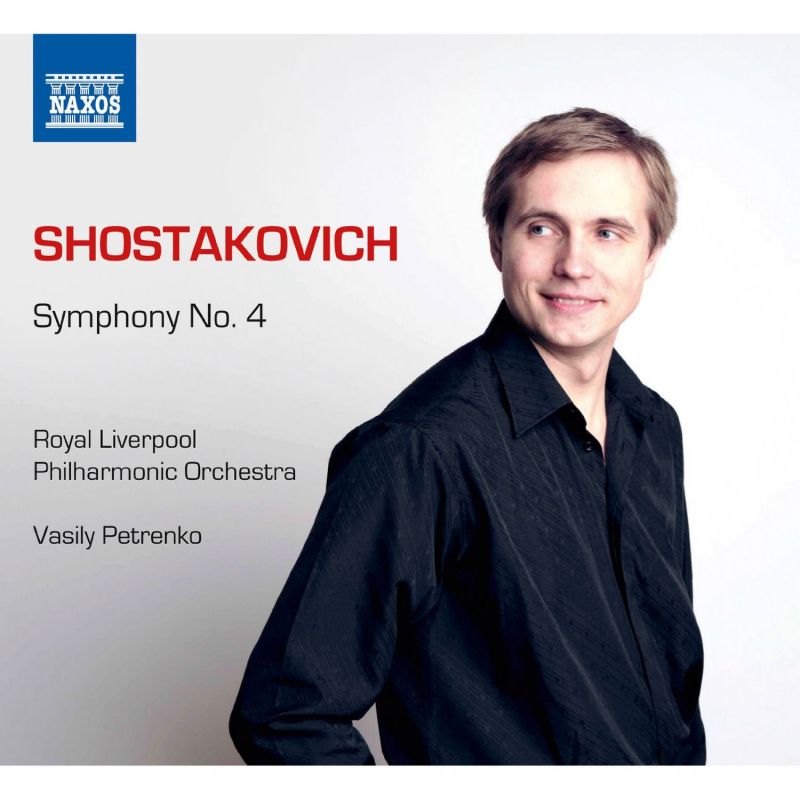SHOSTAKOVICH Symphony No 4
View record and artist detailsRecord and Artist Details
Composer or Director: Dmitri Shostakovich
Genre:
Orchestral
Label: Naxos
Magazine Review Date: 11/2013
Media Format: CD or Download
Media Runtime: 65
Mastering:
DDD
Catalogue Number: 8 573188

Tracks:
| Composition | Artist Credit |
|---|---|
| Symphony No. 4 |
Dmitri Shostakovich, Composer
Dmitri Shostakovich, Composer Royal Liverpool Philharmonic Orchestra Vasily Petrenko, Conductor |
Author:
The question is how? Shostakovich knew all too well that it wasn’t enough to believe in the integrity of every bar of his most ambitious symphony to date – his creative thinking had to have shape and purpose. Which, of course, is where sonata form came back into the equation. My allusion to the first movement of Mahler’s Third Symphony is an obvious one because the great originality of that epic movement, both in terms of sound and of shape, is nonetheless rooted in traditional symphonic form. In Shostakovich’s Fourth the form may seem more elusive, more ‘disguised’, but it binds the ingredients in extraordinary ways and gives even the uninformed listener a subliminal sense of order. Not that Stalin and his naysayers would have seen it that way. His edict of ‘chaos instead of music’, directed at the time to Shostakovich’s opera The Lady Macbeth of the Mtsensk District, would most certainly have been reapplied to the Fourth Symphony had the composer not withdrawn it from performance. And given that this was undoubtedly the piece in which Shostakovich truly found his voice, it was better, he thought, to shelve it than subject it to yet more state-sponsored derision. Between 1935 and 1961 it languished unheard, until Kondrashin in the Soviet Union and Ormandy in the United States brought it in from the cold. Even today it’s as if the ink is still not dry on the page. Confident and uncompromising, and still somehow work in progress, it’s the symphony, one feels, that Shostakovich always wanted to write.
Petrenko certainly conveys that. The overriding effect of his performance is one of liberation and inevitability. The proximity of Mahler – a kindred spirit in so many respects – is a constant source of inspiration. The mysterious departure into uncharted regions at what might loosely be called the start of the first-movement development is like regressing into the childhood reveries of the wayfarer from Mahler’s First Symphony – but with a darker, more unearthly purpose: the solo horn brings solace but the cuckoo’s familiar call is distorted in the E flat clarinet.
Then there is that madcap string fugue which Shostakovich seems to fling down like a gauntlet. You don’t know where it came from or why it’s there but it’s taking you somewhere you may or may not want to go, and at Petrenko’s devil-may-care tempo you fasten your seat belt. The speed beggars belief but the articulation is a step up from even that. The Royal Liverpool Philharmonic Orchestra strings took this passage home for practice, that’s for sure – I’ve heard it scrambled at a fraction of this tempo.
I’ve alluded to the tension between waking and dreaming, and Petrenko’s ruthless clarity makes it hard to separate the two. The spooky scherzo and the finale’s circus-like divertissement sharpen the composer’s irony to a razor edge. Again Mahler had taught him how lethal that could be. So the opening funeral march sounds like a cross between Gounod’s ‘Funeral March of Marionette’ and the ‘Huntsman’s Funeral’ in the third movement of Mahler’s First Symphony, with comedy and tragedy indivisible. Therein, I think, lies the essence of the piece. The unexpected final climax (over the two sets of timpani ostinato) really does sound like the triumph of self-destruction – and, as the open-ended final page drifts into solitude like a wilful non sequitur, one’s mind drifts back to the skeletal ticking of the percussion at the close of the scherzo. This ‘time’ motif will accompany Shostakovich to the final pages of his last symphony and beyond. Rostropovich once told me that he imagined this to be the letting down of a silken ladder to eternity. Perhaps the best of Petrenko’s much-praised cycle, then, and a strong contender for ‘best in catalogue’. The skewed logic of thepiece is made gripping, the disparate and the enigmatic reconciled.
Discover the world's largest classical music catalogue with Presto Music.

Gramophone Digital Club
- Digital Edition
- Digital Archive
- Reviews Database
- Full website access
From £8.75 / month
Subscribe
Gramophone Full Club
- Print Edition
- Digital Edition
- Digital Archive
- Reviews Database
- Full website access
From £11.00 / month
Subscribe
If you are a library, university or other organisation that would be interested in an institutional subscription to Gramophone please click here for further information.




